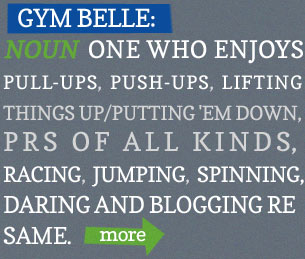Gym Belle Q&A: Strength, Endurance and Marathon Training
As I re-orged the content on this site this week as part of this re-design, I realized that I have a lot of unpublished material. The following is a post I wrote in November of 2011, about two weeks after I ran the New York City Marathon. At the time, I had my reasons for not publishing this piece. As training season for 2012 approaches (for others, not me!), I've decided it's time to share.
Jen G. recently posted Sarah Wilson's article Strength and Endurance: Can We Have Both? on my Facebook page asking if I agree.
Make no mistake: strength and endurance are not mutually exclusive. In my experience, it's the squats that get you up the hills.
On November 6, 2011, I ran my first marathon. I finished in 4:42:09. To the extent I was interested in my time, I had been hoping to beat 4:30. I really wasn't all that concerned, though, and 4:42 seemed respectable enough. What mattered most to me was that I was able to enjoy the majority of the experience. I felt awesome through mile 15, good through 19 and somewhat nauseous and ready to be done from 22-24. When I got to 24, I realized I had a good deal more in the tank and picked up my pace. I sprinted across the finish line. I'm smiling in most of the pictures people snapped. Perhaps this means I could have gone faster throughout. I'm ok with that.
Marathon morning, I wasn't nervous. I was mildly concerned that I'd have to stop to pee, and mildly irked that I had my period on race day. I had no doubt, however, that I could manage to run for however long it would take me to cover 26.2 miles. I had this confidence despite the fact that I had never run more than 13.1 miles in my life.
I can say this now, but throughout my training and even on race day, I was loath to voice this conviction to anyone. On the ferry ride to Staten Island where the race began, I sat next to a woman who had run two other marathons. When she heard I was a first-timer, she looked at me and said, "You've done your long runs, right?" I lied and said yes. "Well, you'll be fine then." Incidentally, I passed her coming out of the Bronx.
I trained with NYC Endurance, using a CrossFit Endurance plan. I started with them four weeks late, 12 weeks from the race. Each Sunday, my coach emailed me the week's schedule. It invariably included one day of short sprints, one day of slightly longer sprints and one day of a longer time trial or tempo run. The plan prescribed my target speeds and specified the exact amount of time to rest between rounds. The workouts were always strenuous. There was only one day in those 12 weeks when I got to go out and just run without being focused on meeting a specific time goal. There's more sophistication to the plan then I'm knowledgeable enough to articulate. For example, we did a few workouts that involved multiple 5K's run with five minute breaks between. As I understand it, those breaks weren't meant to make it easier - they were meant to allow our legs to get stiff, to get the lactic acid to build up so that we'd get used to pushing past that discomfort of starting up again on the next round.
In addition to the running, my schedule included four to six CrossFit workouts each week. Usually, those workouts involved both a strength component and a metabolic conditioning WOD. The strength workouts came in two flavors: max effort and dynamic effort. The latter was new to me and involved short sets of reps at regular intervals at 50-60% of my max for that lift. The goal of this was increased explosiveness. At least once a week - and usually more- I had to double up my workouts, doing one before work and the other later that night to get it all in.
The first two weeks were rough. I thought that since I already worked out five or six days a week, I'd be fine. There was a real adjustment period, though. Those few extra workouts exposed a lot of weaknesses. The first thing I noticed was that proper hydration was totally non-negotiable. I had to make a conscious effort to drink water throughout the day or I'd get sluggish. Veggies were also crucial. I follow a paleo diet, so I don't eat grains. My carbs come from mostly from veggies and also from fruit. It takes a lot of veggies to workout intensely twice a day. Finally, sleep was mandatory. I could not force my body out of bed after my usual five hours - it just wouldn't cooperate. (Sadly, this meant no time to blog.) When any one of those areas was compromised, I'd quickly notice symptoms associated with over-training: swollen glands, loss of appetite, etc. The issue wasn't the training, though; it was my hydration/nutrition/sleep.
When I discussed my training plan with people, they almost inevitably focused not on what I was doing each week, but on what I wasn't doing: long, slow distances. I was frequently asked why I would take that kind of risk. "That's an interesting experiment," one friend commented. I disagreed with the characterization, but I never argued. I'm guess I'm not that interested in prosthelytizing.
Whence my faith in the program? I had seen what CrossFit had done for every area of my fitness capacity over the previous year and a half. It just works. So if this was the "CrossFit way" to do endurance, I had little doubt that it would work. I had done my Google research and could not find any criticism of the plan by anyone who had actually tried it. For me, that spoke volumes.
This style of training came with some very real perks. First, I got faster. I'm a slow runner so it was nice to see real significant gains in terms of speed. Second, I never got sick of running. A lot of my friends were burnt out by the time the marathon rolled around. Who could blame them - they'd been doing long runs for months. The third and perhaps most compelling perk was the lack of injury. It's frequently said that injuries from running are inevitable; I think that's hooey. You just need to be smart about it - i.e. lots of proper mobilizing and truly efficient mileage. Fourth, no other area of my fitness had to be sacrificed during my training. I got to keep on getting stronger and generally more awesome through regular CrossFitting. For me, that was huge.
The downsides of the plan seemed negligible in comparison. I didn't get to have the peace of mind that comes with having done something before. After 13.1, I was in totally new territory. I've heard of people having wonky, unexpected things happen the first few times they pass the 15 mile marker. I'd be doing that on race day. I also had no clue what I'd want to eat in the later miles. Would I want the caffienated GU or would I be better off without it? (My coach tells me that my late-race nausea was actually the result of too much GU sugar.) Would my otherwise comfortable shorts start chaffing at the end? I can't pretend I didn't worry about these things - I most definitely did - but, to me, that anxiety was worth it.
Would I recommend training this way to other people? Wholeheartedly with a significant caveat: I think you need to have a really solid CrossFit base before you layer on the endurance portion. So, if you're not a CrossFitter, start with that for a while before training season.
Sweat happy.
-Gym Belle-







 Post a Comment
Post a Comment



Reader Comments